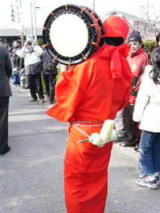 |
'Tenteko' is an onomatopoeia of the drumming sound.
Please listen to the sound of 'tenteko'.
TENTEKO FESTIVAL
(Tenteko Matsuri)
January 3
1:00p.m. -
 |
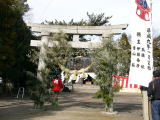 |
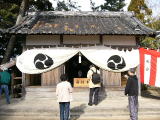 |
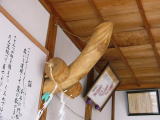 |
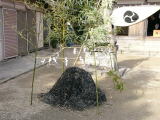 |
| torii or shrine gate | Hachimansha main shrine |
inside of the main shrine | ash for the ritual |
Tenteko Festival was started in 859.
In this year, rice fields in Niike area were selected as Shinden (rice
fields for gods) for the Daijo-sai.
Daijo-sai is held only once in one Emperor's period, and it's the First
Great Thanksgiving Service
after the enthronement of an Emperor of Japan.
Hachimansha (shrine) was built concerning this ritual, and the rice harvested
Niike area was offered
to Ise Shrine by Emperor Seiwa.
This festival was originally a rice planting ritual.
Then it changed to a rich harvest festival and has been kept until now.
We can know the styles of living in old days with this festival,
and it was designated for a intangible cultural folk asset of Aichi Prefecture.
![]()
The parade of the Tenteko Festival starts from near Niike-cho Kominkan
(comunity center) at 1: 00 p.m.
and walk to Hachiman-sha (shrine) slowly
| order of the parade | . | ||||
| tail | <- | <- | <- | head | goal |
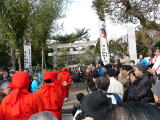 |
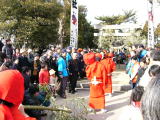 |
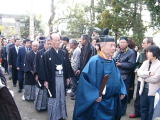 |
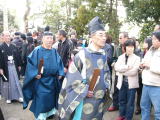 |
 |
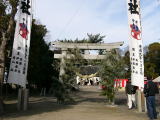 |
| yaku-otoko (men of bad luck age) three men who have bamboo brooms |
yaku-otoko (men of bad luck age) *the 1st man has a small drum/shimedaiko *the 2nd man has a rice chest * the 3rd man has fish, tea container and namasu |
president and representatives of Niike town |
shinto priest (R) and shrine keeper (L) |
sakigake (salt shaker) to purify the way to the shrine |
Hachimansha (shrine) |
Stars of this festival are six yaku-otoko with red kimono and masks.
It is said that a red kimono is a relic of bygone days when rice planting
had been thought very sacred work.
and that wearing a red kimono or hiding one`s face with a mask was a sign
of god.
Farmers transformed themselves to gods and had rituals of rice plantings.
Now the ritual is simplified, but in old days people stayed in the shrines
for one week to purify themselves,
then they took their roles.
| 1st yaku-otoko | 2nd yaku-otoko | 3rd yaku-otoko | ||
 |
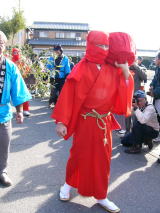 |
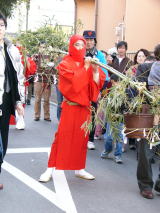 |
||
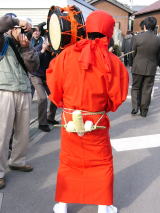 |
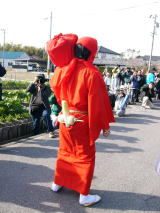 |
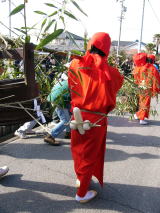 |
||
| The first three men put phalluses made of radish on their hips. They thrust their hips in time with the beat of a drum. Male is likened to a seed and female is likened to a rice field in Japan. So their action shows sowing and vital energies. The second man carries a rice chest, and the third man carries namasu (vinegared dish of raw meat or fish) and raw fish (bora/mullet ). They show the style of lunch time during the rice planting season in old days. At that time, farmers usually had meal twice a day, breakfast and supper. But during the rice planting season, women took lunch called 'hirumamochi'' to the rice field. |
||||
| 4th, 5th and 6th yaku-otoko |
||
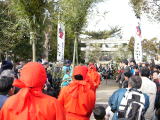 |
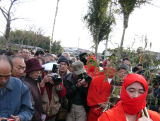 |
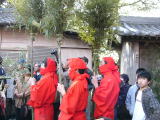 |
| They have bamboo brooms to scatter ash. If the ash fall on you, it means that you got talisman. |
||
![]()
process
| -> | * | -> | -> | * |
 |
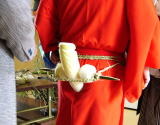 |
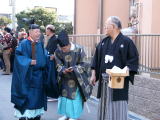 |
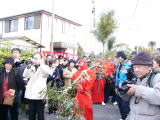 |
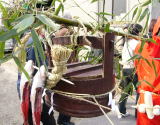 |
| preparation at kominkan or community center |
ahem | chatting before the parade | start | fish (made in the shape of the female genitals) |
| -> | -> | -> | -> | -> |
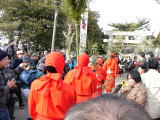 |
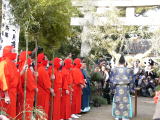 |
 |
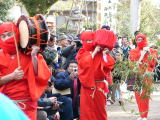 |
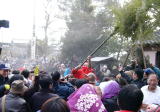 |
| arrive at Hachimansha | shinto ritual in front of the main gate |
purified and drink sake in the main shrine |
walk around the shrine precincts three times |
Yaku-otoko scatter ash with bamboo brooms. It shows composting to rice fields. |
| -> | -> | -> | final | ||
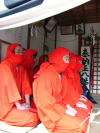 |
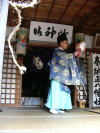 |
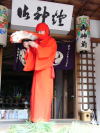 |
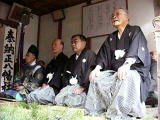 |
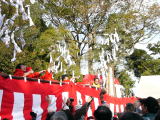 |
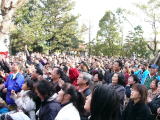 |
| listen to the norito |
Senshu-banzairaku | sing 'taue-uta /rice planting song ' | mochinage throw rice cakes |
get rice cakes | |
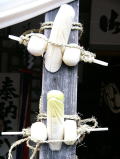 |
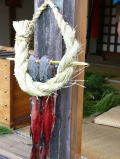 |
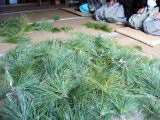 |
 |
| These decoration of genitals show the power of production. Farmers pray for luxuriance of rice |
People throw pine leaves into the main shrine. They are thought as substitutes for seedlings of rice plants. |
sumeshi vinegar taste rice with pickled vegetables and fish flow by local followers. |
|
![]()
access
Take Meitetsu express bound for Nishio.
Change the train at Nishio Station to the local train bound for Gamagori.
Get off at Fukuchi station (next station)
Walk 10 minutes.
| ex. Take the 10:51 a.m. express bound for Nishio on the Meitetsu Line from Meitetsu Nagoya station.(Track No.4) Arrive at Nishio station at 11:29 a.m. You will find a train for Gamagori on the line left side (Track No.2) The train leaves at 11:47 and arrives at Fukuchi station at 11:50. Get off the train and cross the tracks and turn to the left along the tracks. Cross the street and go straight. You will see white guardrails and greenhouses. Cross the street with traffic signals and go straight. You will find many flags of the shrine and thick trees on the right. That's the Hachiman Shrine yard. 2007 |
inquiries
Nishio Kanko Kyokai
0563-56-2111